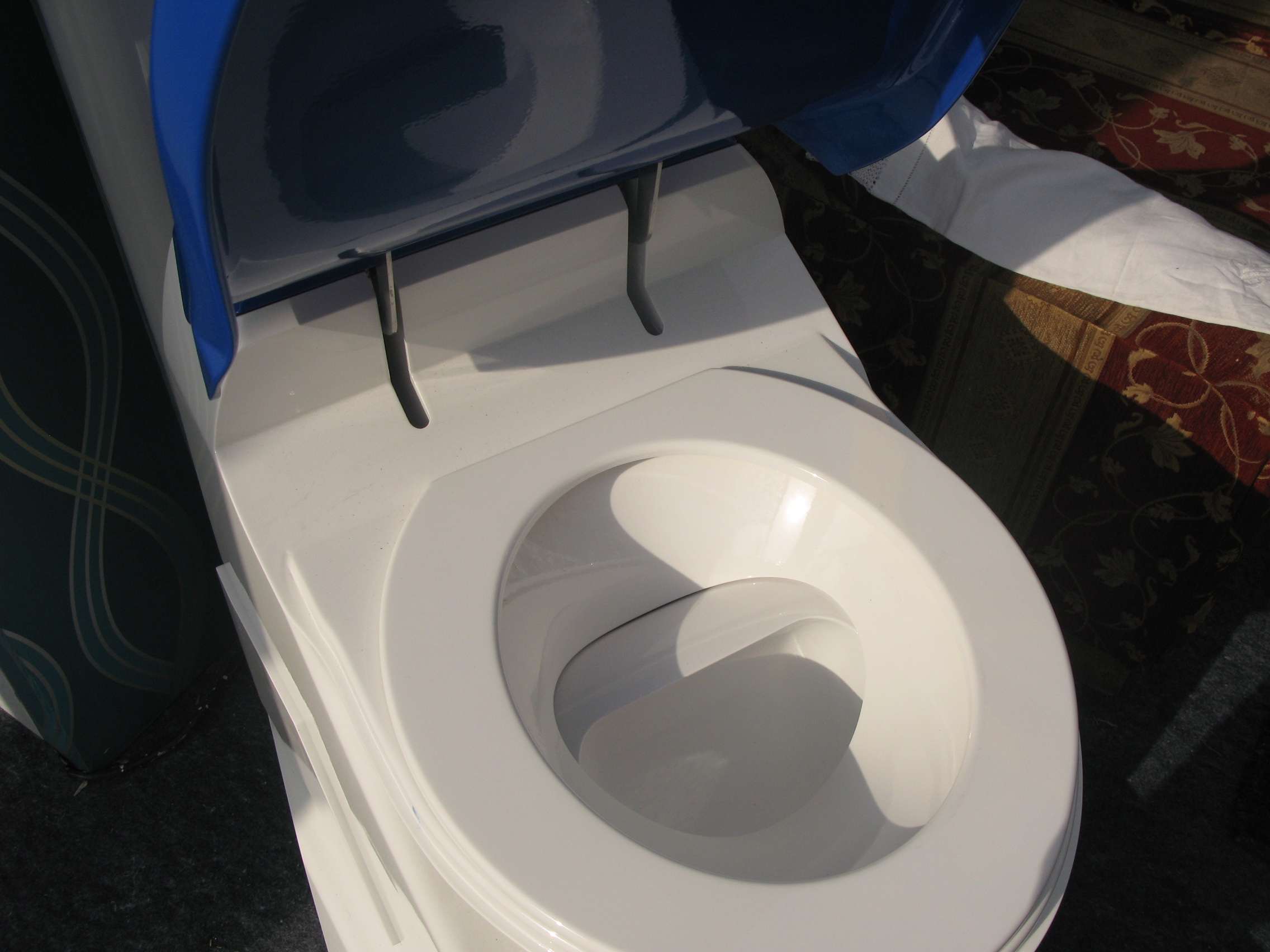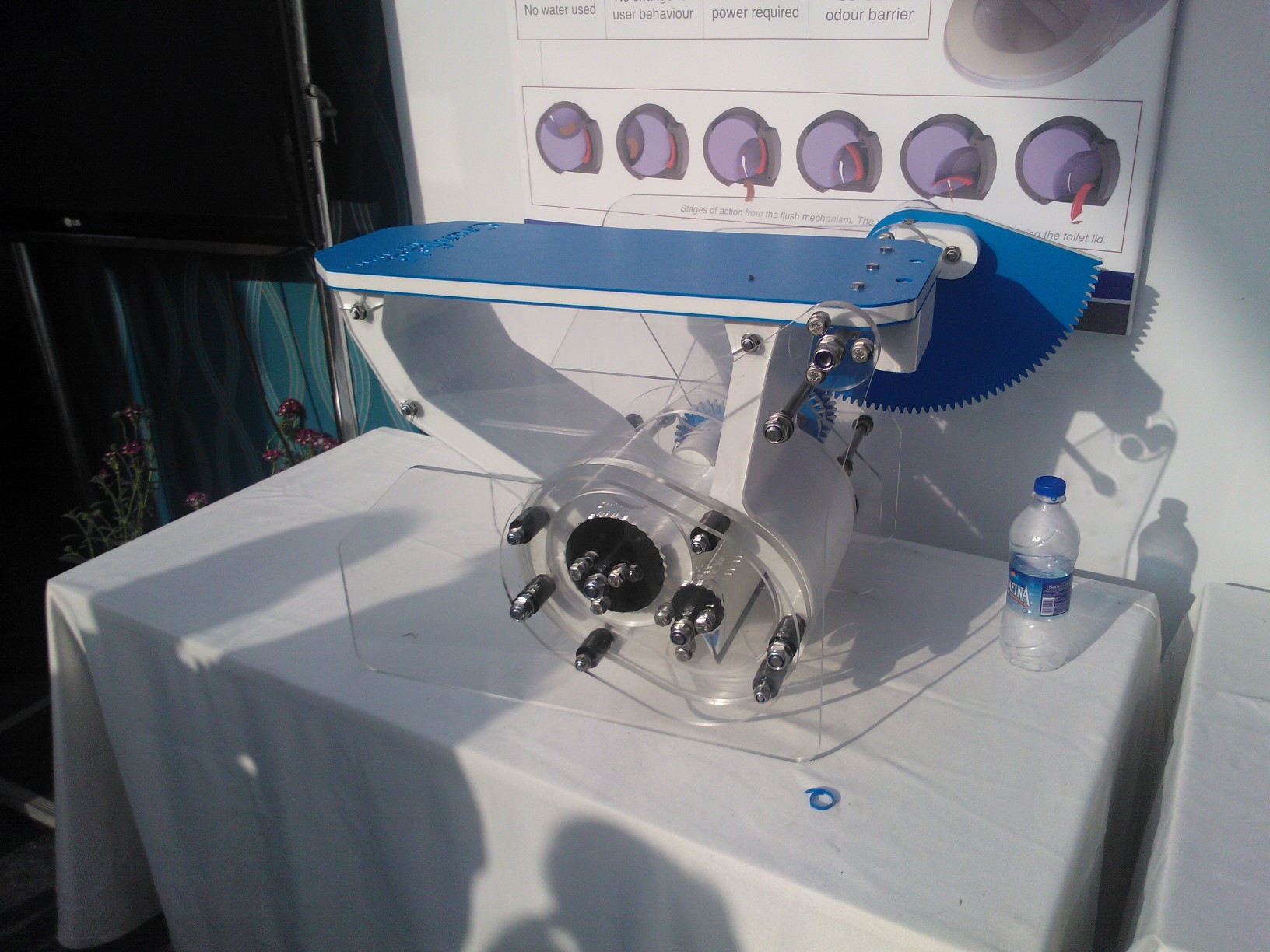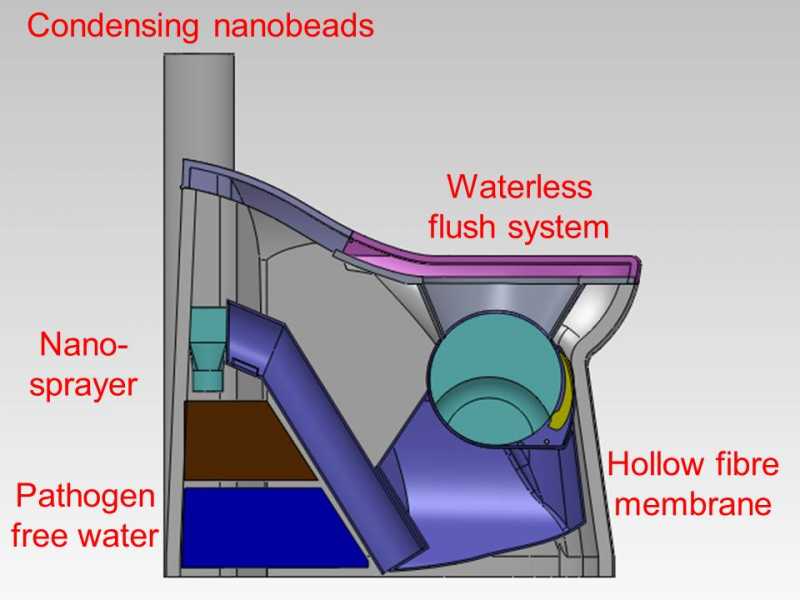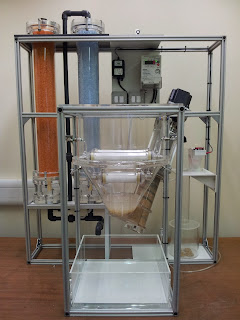- Forum
- categories
- Sanitation systems
- Toilets without urine diversion
- Innovations and research in toilet design
- The Nano Membrane Toilet (Cranfield University, UK) - new phase of funding until Jan. 2016
The Nano Membrane Toilet (Cranfield University, UK) - new phase of funding until Jan. 2016
54.6k views
Hi Alison,
Congrats on this event. It is great to get the word out.
You say "We’ll have all our prototypes so plenty of chance to try them out" and then you say "And you can even sit on our toilet!", which seem to contradict each other a bit. Optimally, all the users who like should be able to use the toilet and see what the user experience is like. Any chance of that?
Good luck with the exhibition,
Chris Canaday
Congrats on this event. It is great to get the word out.
You say "We’ll have all our prototypes so plenty of chance to try them out" and then you say "And you can even sit on our toilet!", which seem to contradict each other a bit. Optimally, all the users who like should be able to use the toilet and see what the user experience is like. Any chance of that?
Good luck with the exhibition,
Chris Canaday
Conservation Biologist and EcoSan Promoter
Omaere Ethnobotanical Park
Puyo, Pastaza, Ecuador, South America
inodoroseco.blogspot.com
Omaere Ethnobotanical Park
Puyo, Pastaza, Ecuador, South America
inodoroseco.blogspot.com
The topic has been locked.
The Nano Membrane Toilet will form part of an exhibition for Universities Week 2014 at the Natural History Museum in London from 9 to 13 June.
Researchers from Cranfield University will join teams from 44 other UK universities represented at the Museum during the week. The exhibition will include research stations, pop-up performances, debates and live research demonstrations, covering a range of research themes.
The exhibition will be open every day from 10am to 6pm, with late night opening until 10pm on Wednesday 11 June. Cranfield’s Nano Membrane Toilet exhibit will be part of the ‘Environment and Sustainability’ theme and will be based in the Atrium. We’ll have all our prototypes so plenty of chance to try them out. You can see how much power you can generate with our hand crank generator. You can try our waterless flush. You can see our hydrophobic and hydrophilic coatings in action. And you can even sit on our toilet!
There’s a full list of all the events happening for Universities week here:
www.universitiesweek.org.uk/
Researchers from Cranfield University will join teams from 44 other UK universities represented at the Museum during the week. The exhibition will include research stations, pop-up performances, debates and live research demonstrations, covering a range of research themes.
The exhibition will be open every day from 10am to 6pm, with late night opening until 10pm on Wednesday 11 June. Cranfield’s Nano Membrane Toilet exhibit will be part of the ‘Environment and Sustainability’ theme and will be based in the Atrium. We’ll have all our prototypes so plenty of chance to try them out. You can see how much power you can generate with our hand crank generator. You can try our waterless flush. You can see our hydrophobic and hydrophilic coatings in action. And you can even sit on our toilet!
There’s a full list of all the events happening for Universities week here:
www.universitiesweek.org.uk/
Alison Parker
www.nanomembranetoilet.org
Apply to study our MSc in Community Water and Sanitation:
www.cranfield.ac.uk/courses/masters/comm...-and-sanitation.html
www.nanomembranetoilet.org
Apply to study our MSc in Community Water and Sanitation:
www.cranfield.ac.uk/courses/masters/comm...-and-sanitation.html
The topic has been locked.
- Elisabeth
-

- Moderator
- Freelance consultant since 2012 (former roles: program manager at GIZ and SuSanA secretariat, lecturer, process engineer for wastewater treatment plants)
Less- Posts: 3372
- Karma: 54
- Likes received: 931
I am attaching some photos of Alison's exhibit from the Toilet Fair below, for people who cannot view the Youtube videos that are included in her blog post.
You find them all in this album on flickr:
www.flickr.com/photos/gtzecosan/sets/72157644242995466/
 The vision of a toilet that is small - and pleasant - enough to fit inside someone's home (prototype but not fully functional)
by
Sustainable sanitation
, on Flickr
The vision of a toilet that is small - and pleasant - enough to fit inside someone's home (prototype but not fully functional)
by
Sustainable sanitation
, on Flickr
 Inside the Nano Membrane Toilet with bowl in mid-rotation of flushing mechanism (no water used)
by
Sustainable sanitation
, on Flickr
Inside the Nano Membrane Toilet with bowl in mid-rotation of flushing mechanism (no water used)
by
Sustainable sanitation
, on Flickr
 A prototype of the flushing mechanism
by
Sustainable sanitation
, on Flickr
A prototype of the flushing mechanism
by
Sustainable sanitation
, on Flickr
 Solid-liquid separation and diffusion of water through hydrophobic membranes in the front unit. Deposition of water droplets on nano-coated beads in the tubes in the back. Transport of solids through the mechanical screw that points up and to the right.
by
Sustainable sanitation
, on Flickr
Solid-liquid separation and diffusion of water through hydrophobic membranes in the front unit. Deposition of water droplets on nano-coated beads in the tubes in the back. Transport of solids through the mechanical screw that points up and to the right.
by
Sustainable sanitation
, on Flickr
P.S. Here is the link to the interview I did with Alison about the research project in general:
And here is the technical explanations on their exhibit:
And here is a professionally done promotional video explaining the concept:
You find them all in this album on flickr:
www.flickr.com/photos/gtzecosan/sets/72157644242995466/




P.S. Here is the link to the interview I did with Alison about the research project in general:
And here is the technical explanations on their exhibit:
And here is a professionally done promotional video explaining the concept:
Dr. Elisabeth von Muench
Freelance consultant on environmental and climate projects
Located in Ulm, Germany
This email address is being protected from spambots. You need JavaScript enabled to view it.
My Wikipedia user profile: en.wikipedia.org/wiki/User:EMsmile
LinkedIn: www.linkedin.com/in/elisabethvonmuench/
Freelance consultant on environmental and climate projects
Located in Ulm, Germany
This email address is being protected from spambots. You need JavaScript enabled to view it.
My Wikipedia user profile: en.wikipedia.org/wiki/User:EMsmile
LinkedIn: www.linkedin.com/in/elisabethvonmuench/
The topic has been locked.
See our latest blog post with photos from the Reinvent the Toilet Fair in Delhi, a video tour of our stand (made by Elisabeth and Arno) and downloads of the posters and brochures we had there.
nanomembranetoilet.blogspot.co.uk/2014/0...reinvent-toilet.html
nanomembranetoilet.blogspot.co.uk/2014/0...reinvent-toilet.html
Alison Parker
www.nanomembranetoilet.org
Apply to study our MSc in Community Water and Sanitation:
www.cranfield.ac.uk/courses/masters/comm...-and-sanitation.html
www.nanomembranetoilet.org
Apply to study our MSc in Community Water and Sanitation:
www.cranfield.ac.uk/courses/masters/comm...-and-sanitation.html
The following user(s) like this post: Elisabeth, secretariat
You need to login to reply
The topic has been locked.
Thanks for this great summary, Elisabeth!
To answer some of your outstanding questions:
The flush mehcniams is still beign built so we don't have any photos of it yet but there's a video of how it will work on our blog.
Yes, it is just the urinary water and some of the faecal water that is separated out. But this vastly reduces the volume of the unsafe waste that needs to be dealt with and provides waster in hioems where otherwise water can be expensive, time consuming to collect and only available intermittently.
We're still working on reducing the energy requirement of the toilet so we can't publish the total energy requirement yet.
Happy to answer any other questions this raises!
To answer some of your outstanding questions:
The flush mehcniams is still beign built so we don't have any photos of it yet but there's a video of how it will work on our blog.
Yes, it is just the urinary water and some of the faecal water that is separated out. But this vastly reduces the volume of the unsafe waste that needs to be dealt with and provides waster in hioems where otherwise water can be expensive, time consuming to collect and only available intermittently.
We're still working on reducing the energy requirement of the toilet so we can't publish the total energy requirement yet.
Happy to answer any other questions this raises!
Alison Parker
www.nanomembranetoilet.org
Apply to study our MSc in Community Water and Sanitation:
www.cranfield.ac.uk/courses/masters/comm...-and-sanitation.html
www.nanomembranetoilet.org
Apply to study our MSc in Community Water and Sanitation:
www.cranfield.ac.uk/courses/masters/comm...-and-sanitation.html
The topic has been locked.
- Elisabeth
-

- Moderator
- Freelance consultant since 2012 (former roles: program manager at GIZ and SuSanA secretariat, lecturer, process engineer for wastewater treatment plants)
Less- Posts: 3372
- Karma: 54
- Likes received: 931
Dear all,
I am writing this post to provide people who don't have access to Youtube videos with a quick overview of what Alison presented during the fourth webinar that SEI organised on 26 November (see Arno's post about it here: forum.susana.org/forum/categories/139-ge...mit=12&start=12#6564).
Alison’s presentation starts exactly here in the Youtube video:
(the total duration of presentation and Q&A session was 16 minutes)
Title: Nano Membrane Toilet
by Alison Parker, a lecturer at Cranfield University
The powerpoint slides that she used:
Note a more detailed presentation from November 2013 is available here on the project's website:
www.nanomembranetoilet.org/publicationsandreports.php
Schematic of the different components making up the system (taken from the more detailed presentation mentioned above):
Notes that I took from her presentation to explain the processes/toilet:
(1)
Question by Luiza Campos: "How is the water treated for reuse?"
Answer by Alison:
"Water that passes through the membrane (as vapour) is pure water – maybe only still containing some volatile organic components and ammonia, but nothing else; The ammonia and VOC are adsorbed on the beads. The beads are there to condense the water that has passed through the membrane.”
(2)
Question by Luiza: "How does the cost of such a toilet compare to a UDDT?"
Answer by Alison:
"Like all the grantees, we are aiming for less than 5 cents per user per day – we think we can make that. It may look high-tech but all the components are off the shelf components, including the membranes. The energy generation from the faeces could offset some of the costs in future. We still have to do detailed financial modelling.”
(3)
Question by Dorothee: "What actual testing have you done so far – with real faeces?"
Answer by Alison:
"We have only tested the system with synthetic faeces. We would like to use real faeces but we don’t want to make the unit unclean because it will need to be exported (to India for the fair in March) and we might have problems then with the transport.”
(4)
Question by Marc Deshusses: "Have you observed a decrease in permeability of the membrane over time due to a growing biofilm?"
Answer by Alison:
"We are not expecting problems with fouling because the membrane is hydrophobic and doesn’t get wetted. Only the water vapour passes through. But we haven’t done long-term tests yet. However, this is not a novel membrane, it exists as an off the shelf membrane.”
(5)
Question by Nelson: "Is the recovered water really pathogen free?"
Answer by Alison:
"As we have not tested the toilet with real faeces we have no proof but it is theoretically not possible that pathogens pass through the membrane (the holes are too small). So the liquid will be pathogen free." [Obviously for the faeces, they still contain pathogens, although this is coated with the nano-polymers to provide a barrier].
(6)
Question by Nelson: "Have you done tests on the nutrient value of the faeces product (N, P, K)?"
Answer by Alison:
"We will thermally process the sludge and the nutrients are not of interest to us (they will be lost). We think that this will be more cost effective, i.e. that energy recovery from the faeces will be more cost effective than trying to reuse the nutrients in the faeces. We think that reusing nutrients in urban areas is too challenging, although we would be happy to hear from others about cases where this has worked.”
If anyone has further questions or comments, then please put them here by replying to this post.
Thank you again to Alison for giving this presentation and for answering our questions!
Regards,
Elisabeth
I am writing this post to provide people who don't have access to Youtube videos with a quick overview of what Alison presented during the fourth webinar that SEI organised on 26 November (see Arno's post about it here: forum.susana.org/forum/categories/139-ge...mit=12&start=12#6564).
Alison’s presentation starts exactly here in the Youtube video:
(the total duration of presentation and Q&A session was 16 minutes)
Title: Nano Membrane Toilet
by Alison Parker, a lecturer at Cranfield University
The powerpoint slides that she used:
This attachment is hidden for guests.
Please log in or register to see it.
Please log in or register to see it.
Note a more detailed presentation from November 2013 is available here on the project's website:
www.nanomembranetoilet.org/publicationsandreports.php
Schematic of the different components making up the system (taken from the more detailed presentation mentioned above):
Notes that I took from her presentation to explain the processes/toilet:
- This will be a household scale toilet, which should fit into a bathroom. It should be aspirational and desirable.
- They thought it was critical to have a flush mechanism – but not with water. The “flush mechanism” separates the waste from the user (both visually and in terms of smell). There is no urine diversion. As the lid closes, the bowl rotates; it is subsequently scraped clean (follow-up questions: do you have photos of this? Does this scraping mechanism really work well in the longer term?)
- The waste enters a chamber where the hollow fibre membranes are located. These membranes are there to reduce the liquid content of the waste. The membrane is hydrophobic (= repels water) and it doesn’t foul. Water vapour goes through the membrane, but water in a liquid state doesn't; this water vapour is condensed on beads which are in bead columns. They are experimenting with different materials for the beads: glass, silica. The beads are super-hydrophilic to attract the water.
- The driving force to push the water vapour through the membrane is a sweep gas. They had initially intended to use a vacuum pump but a sweep gas is proving more efficient. (I don't know what sweep gas is, Alison told me: A sweep gas is a dry gas that’s passed along the inside of the membrane fibres – it has the same effect as the vacuum).
- The water that is condensed on the beads from the vapour is extremely clean (could in theory even be drunk) – could be used for washing clothes or around the house in general (follow-up question: how much water would be “generated” in a normal household in this way? As it is only the water from the urine and some from the faeces, it is only 2 L per person per day or so? Is it worth all the effort for this small amount of water? Is it mainly because otherwise one would have the issue of having to transport this liquid out of the house?).
- The remaining solids sludge (25% solids content, i.e. 75% water) goes to the nanomister via a screw conveyer: here a mist of water and polymer is applied with nano-particles (this is where the term “Nano-Membrane Toilet” comes from). This creates a coating over the solid waste to limit pathogen spread and odour. (follow up question: 25% solids content strikes me as quite low, given that normal faeces has already 20% solids content. This is telling me that not much water is removed in the process with the membranes? Only the liquid from the urine really and nothing from the faeces, correct?)
- In the photo of the works-like prototype (see below) you see in the front middle the chamber with the membranes (currently at the end of a cycle); towards the bottom you see the solids that have settled; towards the right is a screw press to move the solids to the nanomister; on the right side you see the nano mister to apply the coating. The flush mechanism is not shown in the prototype. - Do you have a photo of the flush mechanism?
- Power for the toilet will be by human power (hand crank or bicycle); only minimal power is required: for the membrane (to supply the sweep gas, for the screw pump and for the nano-mister. (could you quantify the total power requirement by comparing with a 60 W lightbulb?)
- The coated solids would be removed from the toilet about once per week (by a service provider). Then they want to extract energy from the solids in a more centralised facility, e.g. for 40 households (why only 40?). They are talking to different companies like Janicki Industries (www.janicki.com/) and Uniliver (or in fact DPS Ltd - a company who are, like Cranfield Uni, a subcontractor on Unilever’s Reinvent the Toilet grant); also looking at a small pyrolysis unit.
(1)
Question by Luiza Campos: "How is the water treated for reuse?"
Answer by Alison:
"Water that passes through the membrane (as vapour) is pure water – maybe only still containing some volatile organic components and ammonia, but nothing else; The ammonia and VOC are adsorbed on the beads. The beads are there to condense the water that has passed through the membrane.”
(2)
Question by Luiza: "How does the cost of such a toilet compare to a UDDT?"
Answer by Alison:
"Like all the grantees, we are aiming for less than 5 cents per user per day – we think we can make that. It may look high-tech but all the components are off the shelf components, including the membranes. The energy generation from the faeces could offset some of the costs in future. We still have to do detailed financial modelling.”
(3)
Question by Dorothee: "What actual testing have you done so far – with real faeces?"
Answer by Alison:
"We have only tested the system with synthetic faeces. We would like to use real faeces but we don’t want to make the unit unclean because it will need to be exported (to India for the fair in March) and we might have problems then with the transport.”
(4)
Question by Marc Deshusses: "Have you observed a decrease in permeability of the membrane over time due to a growing biofilm?"
Answer by Alison:
"We are not expecting problems with fouling because the membrane is hydrophobic and doesn’t get wetted. Only the water vapour passes through. But we haven’t done long-term tests yet. However, this is not a novel membrane, it exists as an off the shelf membrane.”
(5)
Question by Nelson: "Is the recovered water really pathogen free?"
Answer by Alison:
"As we have not tested the toilet with real faeces we have no proof but it is theoretically not possible that pathogens pass through the membrane (the holes are too small). So the liquid will be pathogen free." [Obviously for the faeces, they still contain pathogens, although this is coated with the nano-polymers to provide a barrier].
(6)
Question by Nelson: "Have you done tests on the nutrient value of the faeces product (N, P, K)?"
Answer by Alison:
"We will thermally process the sludge and the nutrients are not of interest to us (they will be lost). We think that this will be more cost effective, i.e. that energy recovery from the faeces will be more cost effective than trying to reuse the nutrients in the faeces. We think that reusing nutrients in urban areas is too challenging, although we would be happy to hear from others about cases where this has worked.”
If anyone has further questions or comments, then please put them here by replying to this post.
Thank you again to Alison for giving this presentation and for answering our questions!
Regards,
Elisabeth
Dr. Elisabeth von Muench
Freelance consultant on environmental and climate projects
Located in Ulm, Germany
This email address is being protected from spambots. You need JavaScript enabled to view it.
My Wikipedia user profile: en.wikipedia.org/wiki/User:EMsmile
LinkedIn: www.linkedin.com/in/elisabethvonmuench/
Freelance consultant on environmental and climate projects
Located in Ulm, Germany
This email address is being protected from spambots. You need JavaScript enabled to view it.
My Wikipedia user profile: en.wikipedia.org/wiki/User:EMsmile
LinkedIn: www.linkedin.com/in/elisabethvonmuench/
Attachments:
-
 reinventin...wash.jpg
(Filesize: 33KB)
reinventin...wash.jpg
(Filesize: 33KB)
The topic has been locked.
Lead post on this thread now updated, i.e. this one:
forum.susana.org/forum/categories/105-pr...d-university-uk#3409
forum.susana.org/forum/categories/105-pr...d-university-uk#3409
Alison Parker
www.nanomembranetoilet.org
Apply to study our MSc in Community Water and Sanitation:
www.cranfield.ac.uk/courses/masters/comm...-and-sanitation.html
www.nanomembranetoilet.org
Apply to study our MSc in Community Water and Sanitation:
www.cranfield.ac.uk/courses/masters/comm...-and-sanitation.html
The topic has been locked.
Dear all
I would like to announce that Alison Parker will be participating in the next expert webinar hosted by SEI on Tuesday 26 Nov at 16:30 CET.
During this webinar, you will get the chance to see a live presentation of the project and recent achievement and ask questions. The programme is the following:
Introduction
Presentations (5 min presentation, 10 min discussion)
(1) Nano Membrane Toilet (Cranfield University), Alison Parker
(2) New concepts for on-site sanitation based on bio-additives and pit design (London School of Hygiene and Tropical Medicine), Jeroen Ensink
(3) Sol-Char Toilet: Using Concentrated Solar Energy to Stabilize Fecal Waste and Produce a Valuable Soil Amendment (University of Colorado, Boulder, USA), Richard (Chip) Fisher and Ryan Mahoney
Wrap-up
Attendance at this webinar is open!
Once recorded, the webinar will also be put online on the SuSanA Youtube channel.
See here for more information: forum.susana.org/forum/categories/139-ge...day-26-november#6427 or contact: This email address is being protected from spambots. You need JavaScript enabled to view it.
Best regards
Dorothee
I would like to announce that Alison Parker will be participating in the next expert webinar hosted by SEI on Tuesday 26 Nov at 16:30 CET.
During this webinar, you will get the chance to see a live presentation of the project and recent achievement and ask questions. The programme is the following:
Introduction
Presentations (5 min presentation, 10 min discussion)
(1) Nano Membrane Toilet (Cranfield University), Alison Parker
(2) New concepts for on-site sanitation based on bio-additives and pit design (London School of Hygiene and Tropical Medicine), Jeroen Ensink
(3) Sol-Char Toilet: Using Concentrated Solar Energy to Stabilize Fecal Waste and Produce a Valuable Soil Amendment (University of Colorado, Boulder, USA), Richard (Chip) Fisher and Ryan Mahoney
Wrap-up
Attendance at this webinar is open!
Once recorded, the webinar will also be put online on the SuSanA Youtube channel.
See here for more information: forum.susana.org/forum/categories/139-ge...day-26-november#6427 or contact: This email address is being protected from spambots. You need JavaScript enabled to view it.
Best regards
Dorothee
WG1 Co-lead
Developing methods and tools to support strategic planning for sustainable sanitation. Particular interested in novel technologies contributing to more inclusive and circular sanitation. This email address is being protected from spambots. You need JavaScript enabled to view it.
Developing methods and tools to support strategic planning for sustainable sanitation. Particular interested in novel technologies contributing to more inclusive and circular sanitation. This email address is being protected from spambots. You need JavaScript enabled to view it.
The topic has been locked.
Hi Pete,
We haven't desigend it for a particular part of the world though a lot of our work has bene informed by a visit the team made to Ghana:
nanomembranetoilet.blogspot.co.uk/2013/0...o-see-challenge.html
We are not generating biogas so we won't be affected by the taboos surrounding biogas which we are well aware of.
We've also changed our plans so we won't require the users the handle the briquettes - the sludge will be collected by a waste collector. You can read our latest description of the toilet here:
www.nanomembranetoilet.org/index.php
I'm interested in your throughts that with a franchise the final costs will escalate - can you explain more?
Alison
We haven't desigend it for a particular part of the world though a lot of our work has bene informed by a visit the team made to Ghana:
nanomembranetoilet.blogspot.co.uk/2013/0...o-see-challenge.html
We are not generating biogas so we won't be affected by the taboos surrounding biogas which we are well aware of.
We've also changed our plans so we won't require the users the handle the briquettes - the sludge will be collected by a waste collector. You can read our latest description of the toilet here:
www.nanomembranetoilet.org/index.php
I'm interested in your throughts that with a franchise the final costs will escalate - can you explain more?
Alison
Alison Parker
www.nanomembranetoilet.org
Apply to study our MSc in Community Water and Sanitation:
www.cranfield.ac.uk/courses/masters/comm...-and-sanitation.html
www.nanomembranetoilet.org
Apply to study our MSc in Community Water and Sanitation:
www.cranfield.ac.uk/courses/masters/comm...-and-sanitation.html
The topic has been locked.
- peteuk
-
 Less
Less- Posts: 1
- Likes received: 0
Hi
You mentioned its for dense urban areas, which part of the world are you looking at?
What roughly will be the cost.
Living in Africa, people have mixed feelings about using bio-gas, I know of one hospital where they have a Bio-gas plant installed to use for cooking, but the staff wont use it because of the different odour it gives off, are afraid of getting some ailment or disease from it.
So handling the briquettes will pose another problem. Human waste is different from animal. Talking of briquettes, people here don't see sawdust briquettes as a source of cooking, a lot of sawdust and shaving wasted.
You said it will be franchise, the final costs will escalate.
Thoughts on the end product
Pete
You mentioned its for dense urban areas, which part of the world are you looking at?
What roughly will be the cost.
Living in Africa, people have mixed feelings about using bio-gas, I know of one hospital where they have a Bio-gas plant installed to use for cooking, but the staff wont use it because of the different odour it gives off, are afraid of getting some ailment or disease from it.
So handling the briquettes will pose another problem. Human waste is different from animal. Talking of briquettes, people here don't see sawdust briquettes as a source of cooking, a lot of sawdust and shaving wasted.
You said it will be franchise, the final costs will escalate.
Thoughts on the end product
Pete
The topic has been locked.
Hi Winfried,
You're correct, we are also devleoping a business model for servicing the toilets.
Of course UDDTs and composting toilets are other options. I think there are some places where they've worked really well, and others where they've worked less well. I see the whole of the Reinvent the Toilet Challenge as broadening the sanitation technology options available, so there is a solution for all the diffferent contexts we find globally. Maybe other RTTC teams have something to add here too?
I'm not sure if that answers your question - was there a particular aspect you wanted me to compare the Nano Membrane Toilet and UDDTs/composting toilets on?
If you're interested to hear more we'll be part of the fourth webinar on 26th November (see here: forum.susana.org/forum/categories/139-ge...day-26-november#6427) and there is now an option to follow (subscribe to) our blog:
nanomembranetoilet.blogspot.co.uk/
Alison
You're correct, we are also devleoping a business model for servicing the toilets.
Of course UDDTs and composting toilets are other options. I think there are some places where they've worked really well, and others where they've worked less well. I see the whole of the Reinvent the Toilet Challenge as broadening the sanitation technology options available, so there is a solution for all the diffferent contexts we find globally. Maybe other RTTC teams have something to add here too?
I'm not sure if that answers your question - was there a particular aspect you wanted me to compare the Nano Membrane Toilet and UDDTs/composting toilets on?
If you're interested to hear more we'll be part of the fourth webinar on 26th November (see here: forum.susana.org/forum/categories/139-ge...day-26-november#6427) and there is now an option to follow (subscribe to) our blog:
nanomembranetoilet.blogspot.co.uk/
Alison
Alison Parker
www.nanomembranetoilet.org
Apply to study our MSc in Community Water and Sanitation:
www.cranfield.ac.uk/courses/masters/comm...-and-sanitation.html
www.nanomembranetoilet.org
Apply to study our MSc in Community Water and Sanitation:
www.cranfield.ac.uk/courses/masters/comm...-and-sanitation.html
The topic has been locked.
- Winfried
-

- Joining hands and minds creates much needed livelihood improvements. This is true for energy access and within that for the productive biogas sector
Less- Posts: 2
- Likes received: 2
Hi Alison,
think that the approach is interesting: it's novel, but also leading to add-ons like filters and catridges, and thus requires logistics. So there is a business model needed to cover for such expenses. Presume you have compared this approach with more common approaches, eg seperate liquid solid fraction toilet and composting, how does it compare?
best regards Winfried
think that the approach is interesting: it's novel, but also leading to add-ons like filters and catridges, and thus requires logistics. So there is a business model needed to cover for such expenses. Presume you have compared this approach with more common approaches, eg seperate liquid solid fraction toilet and composting, how does it compare?
best regards Winfried
Awaiting your suggestions, comments,
best regards Winfried Rijssenbeek
best regards Winfried Rijssenbeek
The topic has been locked.
Share this thread:
- Forum
- categories
- Sanitation systems
- Toilets without urine diversion
- Innovations and research in toilet design
- The Nano Membrane Toilet (Cranfield University, UK) - new phase of funding until Jan. 2016
Time to create page: 0.172 seconds









